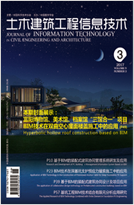2016, 8(6): 1-7. doi: 10.16670/j.cnki.cn11-5823/tu.2016.06.01
于BIM技术和有限元分析的抗浮锚杆优化设计
| 1. | 湘潭大学土木工程与力学学院, 湘潭 411105 |
| 2. | 湘潭市规划建筑设计院, 湘潭 411100 |
| 3. | 四川柏慕联创工程技术服务有限公司, 成都 610015 |
Optimization Design of Anti-floating Anchor Rod based on BIM Technology and Finite Element Analysis
| 1. | College of Civil Engineering and Mechanics, Xiangtan 411105, China |
| 2. | Xiangtan City Planning and Architectural Design Institute, Xiangtan 411100, China |
| 3. | SiChuan LianChuang Engineering Technical Service Limited Company, Chengdu 610015, China |
引用本文:
凌康棋, 许福, 谢大江, 李世才. 于BIM技术和有限元分析的抗浮锚杆优化设计[J]. 土木建筑工程信息技术,
2016, 8(6): 1-7.
doi: 10.16670/j.cnki.cn11-5823/tu.2016.06.01

Citation:
Ling Kangqi, Xu Fu, Xie Dajiang, Li Shicai. Optimization Design of Anti-floating Anchor Rod based on BIM Technology and Finite Element Analysis[J]. Journal of Information Technologyin Civil Engineering and Architecture,
2016, 8(6): 1-7.
doi: 10.16670/j.cnki.cn11-5823/tu.2016.06.01

摘要:建筑的抗浮设计至关重要, 布置抗浮锚杆是地下室抗浮的主要措施之一。地下室和基础的变形位移是锚杆受力变化的根本原因, 传统抗浮锚杆设计方法忽视了基础变形位移差异和锚杆受力的不均匀性, 存在一定不合理性。本文结合BIM技术和有限元方法对某工程实例建立包含锚杆、基础和上部结构的整体模型, 模拟高水位下筏板基础的上浮位移情况。在综合考虑上部结构荷载变化、上部结构刚度和上部结构与基础共同变形受力的前提下进行了有限元分析。结果表明, 传统方案设计布置的锚杆所受拉力不均匀, 存在一定的弊端, 造成浪费。通过BIM技术和有限元分析有针对性地进行优化后, 抗浮锚杆布置更为合理, 达到了节约成本、降低工程风险的优化设计目的; 在上部建筑方案变动时, 利用BIM技术联动修改的优势, 跨平台将修改变更信息导入YJK结构计算软件, 更新上部结构分析模型。上部结构变动导致的上部荷载和刚度变化情况在基础有限元分析模块中重新读取, 完成从建筑方案变更到结构联动修改的全过程, 优化结构设计流程, 更为简洁合理, 为建筑设计人员和结构设计人员协同工作提供了一定的经验参考。
Abstract: The anti-floating design of building is very important, and the arrangement of anti-floating anchor is one of the main measures for anti-floating in the basement. The deformation displacement of the basement and foundation is the root cause of the change of anchor force. The traditional anti-floating anchor design method ignores the difference of foundation deformation displacement and the uneven force of the bolt. Based on the BIM technology and the finite element method, the whole model of the anchor, foundation and superstructure was established to simulate the floating displacement of raft foundation under high water level. The finite element analysis is carried out under the premise of considering the upper structure load variation, the upper structure stiffness, the upper structure and the foundation. The results show that the tension of the anchor rod which is arranged by the traditional scheme design is not uniform, and there are some disadvantages, which result in waste. Anti-floating anchor arrangement is more reasonable by using BIM technology and finite element analysis and save the cost and reduce the project risk. During the change of the superstructure, the advantage of BIM technology is used to modify the data, and the cross platform will change the information into the YJK structure calculation software, and update the upper structure analysis model. The upper load and stiffness leads to changes in the re-read module based on finite element analysis of changes in the superstructure, completes the whole process from the construction project changes to the structure of linkage modification, structures the optimization design process, makes it more brief and reasonable
| [1] |
孙树勋.大型地下工程抗浮锚杆整体优化研究[J].工程质量, 2015(03): 76-80.doi: 10.3969/j.issn.1671-3702.2015.03.018 |
| [2] |
GB 50007-2011建筑地基基础设计规范[S]. 北京: 中国建筑工业出版社, 2011. |
| [3] |
基础设计软件YJK-F用户手册及技术条件[M]. 北京盈建科软件有限责任公司, 2014. |
| [4] | |
| [5] | |
| [6] | |
| [7] |
GB 50009-2012建筑结构荷载规范[S]. 北京: 中国建筑工业出版社, 2012. |
| [8] | |
| [9] |
CECS 22: 2005岩土锚杆(索)技术规程[S]. 北京: 中国计划出版社, 2005. |
| [10] |
GB 50330-2013建筑边坡工程技术规范[S]. 北京: 中国建筑工业出版社, 2013. |
计量
- PDF下载量(19)
- 文章访问量(2623)
- HTML全文浏览量(1116)















